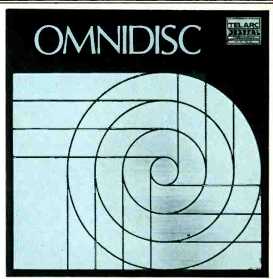
Disc Data: Telarc DG-10073/74, two discs, $29.95.
Company Address: c/o Audio-Technica, 1221 Commerce Dr., Stow, Ohio 44224, USA.
Under the name OmniDisc, Telarc has produced one of the most useful consumer test records I have ever had the privilege of reviewing. The two-re cord set is well packaged, and the enclosed notes are detailed and informative. Let's take it side by side.
Side one does not play. It has engraved on its surface a graduated radial line useful for determining tonearm and cartridge alignment. It works with either pivoted or straight-line tone-arms. There are strobe bands on the label for determining turntable speed. I was able, with this side, to put the finishing touches on my own straight line tracking system.
Side two contains the more usual types of signals--but what a useful array! There are pink-noise signals for determining channel assignment and polarity. Panned noise signals let you hear how clearly, or ambiguously, your system images across the stereo stage. An absolute polarity test lets you check whether or not the entire system is poled according to convention. (A mono signal on the disc moving out from the center should result in both woofer cones moving out into the room.) Low-frequency swept signals help identify tonearm resonances.
An especially useful, mixed-frequency signal in the range of 1 kHz increases in level up to quite high velocities and helps both to determine the maximum tracking ability of a cartridge, and to identify anti-skating alignment problems. This particular signal devastated every phono cartridge in the house except one: The Pioneer PC-1000-II, a superlative Japanese moving-magnet model not sold here. Nonetheless, I would question whether or not this band actually reaches its indicated velocity of 46 cm/S.
The side ends with a series of 1/3-octave noise bands starting at 20 kHz and working on down to 20 Hz. These should be played in mono for best tracking with any cartridge. Although the signals are recorded about 14 dB below RIAA reference level, at extremely high frequencies, tracing distortion is inevitable. Mono playback cleans it up nicety. These signals are useful for overall system equalization when used with a 1/3-octave equalizer and a sound level meter.
Side three presents a set of musical tracking tests. Five difficult sections from previous Telarc releases are presented four times each, with a level increase of 2 dB each time. Thus, the last sample of each set will be 6 dB higher in level than the first. In just about every case, the last two examples represent levels that would rarely be encountered-even on a Telarc disc! These useful sets of excerpts al low you to test your cartridge to its limit. Levels on this side peak out on a VU meter anywhere from +3 to +10 relative to RIAA reference level. Nor mal stereo disc product will have VU peaks not much in excess of +3.
Side four presents a voice-at-a-time version of the fugue from Benjamin Britten's Young Person's Guide to the Orchestra, followed by the complete fugue. Next on this side is a zany version of the old "Good Vibrations," which The Beach Boys made famous back in the '60s. It's done pretty much in Beach Boys style-until all hell breaks loose about halfway through: A low-frequency, synthesized signal, about + 10 dB in level, comes barreling through just when the voices have all but faded out. This will really wipe out a system that hasn't got the electrical or acoustical headroom to handle it. You might think of it as this year's answer to the "1812 Overture." As is usual for Telarc, the pressings are spotless, and there is nary a bit of groove echo on the vocal announcements.
Most of the technical credit for this set goes to Richard Donaldson, the engineer who has designed so much of the disc transfer system at IAM in Irvine, Cal., where Telarc cuts its master discs. But really, we should give credit to anyone who was connected with the venture at all.
- John M. Eargle
(Audio magazine, Feb. 1983)
Also see:
Two Test CDs -- Auditory Demonstrations and Anechoic Orchestral Music Recording (Auricle, July 1989)
= = = =